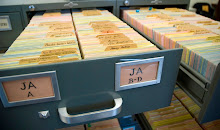We are currently 35% through Encoding Level 1 which involves inputting proofreading corrections, verifying the basic code and creating the first of several authority look-up tables--this one for place names. The work is still broken down by reel. The following is the checklist for each record.
To open a new file for encoding level 1:
--Open new XML file through the Tortoise SVN Directory at C:\Repositories\slipfile\xml\proofread and confirm that the file name ends in “_level1”
--Confirm that FULL_schemaV2_MR.rng is associated through the Tortoise SVN Directory at C:\Repositories\slipfile\xml\schemas (reassociate if the red underlines don’t appear)
--Run the XSL transformation copyformat.xsl; overwrite the new file under same name.
--Commit these changes by right clicking on the slipfile folder on your C:\ drive and selecting "SVN Commit" from the drop down menu. Select the files to commit, click "OK" and then type in your password.
To open a working file for encoding level 1:
--Open XML file through the Tortoise SVN Directory at C:\Repositories\slipfile\xml\level1
--Enter changes and save periodically to the Tortoise SVN Directory at C:\Repositories\slipfile\xml\level1
--When finished with work, commit changes by right clicking on the slipfile folder on your C:\ drive and selecting "SVN Commit" from the drop down menu. Select the files to commit, click "OK" and then type in your password.
For each record:
Input proofreading file changes
--Confirm @color, enter if absent (if you delete the entire @color and hit the space bar, a drop down menu will appear with possible attributes and values). The choices are: 1pink, 2yellow, 3white, 4blue, or 5goldenrod
--Confirm <place>, remove unnecessary information from @location and confirm correct English spelling; confirm place name against Excel spreadsheet list and add new authority names to list i.e. “Philadelphia, 31 South Street” should have a @location value of “Philadelphia”
--Confirm <code>, use drop down prompts to fill in attributes when necessary Codes that are not @type=Accesssion, Letterbook, Miscellany or Diary should be encoded as “General” under the @type, i.e. “TS Wills and Deeds”
--Confirm <length>, enter value in @pages if absent: add multiple page numbers listed, i.e. if there is an enclosure and <length>2 p., 3 p. </length> then the total value for @pages= “5”.
--Confirm <copy>, enter value for @format. The copyformat.xsl should have populated most of these. when there are two values, one for MS and one for XPr (or the like), copy @format should have “Manuscript” as value and the subsequent XPr’s should be encoded as a note
--Confirm <date>, verify that populated dates are correct, confirm all attributes are present as necessary, enter @to for date ranges and any other appropriate @.
Most of the date should be automatically populated, except for date ranges. A date range will have the first date entered as an @when, the encoder must enter the end date in @to as year-month-day. For unknown months or days, enter “99” . For conjectural or corrected dates, encode the corrected date. For questions, check Master Encoding Guide.i.e., "1 January 1799 [i.e. 1800]" should be @when="1800-01-01".
--Add new slips found in paper file, create new ID number at end of reel
--Cross check any changes in the Corrections Binder (may be redundant, but important!)
Tuesday, November 10, 2009
Checklist for Encoding Level 1
Labels:
Checklists,
Codes,
Color,
Copy,
Dates,
Encoding Level 1,
Format,
Length,
Place,
Series
Subscribe to:
Post Comments (Atom)

No comments:
Post a Comment